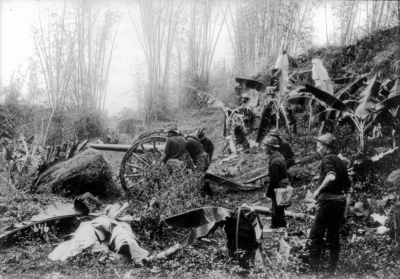The Battle of Manila (Filipino: Labanan sa Maynila; Spanish: Batalla de Manila), the first and largest battle of the PhilippineAmerican War, was fought on February 45, 1899, between 19,000 American soldiers and 15,000 Filipino armed militiamen. Armed conflict broke out when American troops, under orders to turn away insurgents from their encampment, fired upon an encroaching group of Filipinos. Philippine President Emilio Aguinaldo attempted to broker a ceasefire, but American General Elwell Stephen Otis rejected it and fighting escalated the next day. It ended in an American victory, although minor skirmishes continued for several days afterward.
The Philippine–American War or the Filipino–American War (modern Filipino: Digmaang Pilipino–Amerikano), previously referred to as the Philippine Insurrection or the Tagalog Insurgency by the United States, was an armed conflict between the First Philippine Republic and the United States that lasted from February 4, 1899, to July 2, 1902. The conflict arose in 1898 when the United States, rather than acknowledgeing the Philippine's declaration of independence, annexed the Philippines under the Treaty of Paris it concluded with Spain to end the Spanish–American War. The war can be seen as a continuation of the modern Philippine struggle for independence that began in 1896 with the Philippine Revolution against Spain and ended in 1946 with the United States ceding sovereignty.Fighting erupted between forces of the United States and those of the Philippine Republic on February 4, 1899, in what became known as the 1899 Battle of Manila. On June 2, 1899, the First Philippine Republic officially declared war against the United States. The Philippine President Emilio Aguinaldo was captured on March 23, 1901, and the war was officially declared ended by the American government on July 2, 1902, with a victory for the United States. However, some Philippine groups—some led by veterans of the Katipunan, a Philippine revolutionary society which had launched the revolution against Spain—continued to battle the American forces for several more years. Among those leaders was Macario Sakay, a veteran Katipunan member who established (or re-established) the Tagalog Republic in 1902 along Katipunan lines in contrast to Aguinaldo's Republic, with himself as president. Other groups, including the Muslim Moro peoples of the southern Philippines and quasi-Catholic Pulahan religious movements, continued hostilities in remote areas. The resistance in the Moro-dominated provinces in the south, called the Moro Rebellion by the Americans, ended with their final defeat at the Battle of Bud Bagsak on June 15, 1913.The war resulted in at least 200,000 Filipino civilian deaths, mostly due to famine and disease. Some estimates for total civilian dead reach up to a million. Atrocities and war crimes were committed during the conflict, including torture, mutilation, and executions by both sides. The guerrilla warfare tactics employed by the Filipinos propelled the U.S. to forcibly move many civilians to concentration camps, where thousands died, and launch reprisal and scorched earth campaigns. The war and subsequent occupation by the U.S. changed the culture of the islands, leading to the rise of Protestantism and disestablishment of the Catholic Church and the introduction of English to the islands as the primary language of government, education, business, and industry.In 1902, the United States Congress passed the Philippine Organic Act, which provided for the creation of the Philippine Assembly, with members to be elected by Filipino males (women did not have the right to vote until a 1937 plebiscite). This act was superseded by the 1916 Jones Act (Philippine Autonomy Act), which contained the first formal and official declaration of the United States government's commitment to eventually grant independence to the Philippines. The 1934 Tydings–McDuffie Act (Philippine Independence Act) created the Commonwealth of the Philippines the following year, increasing self-governance, and established a process towards full independence (originally scheduled for 1944, but delayed by World War II and the Japanese occupation of the Philippines). The United States eventually granted full Philippine independence in 1946 through the Treaty of Manila.

1899Feb, 4
The Philippine-American War begins with the Battle of Manila.
Choose Another Date
Events on 1899
- 2Feb
Canberra
The Australian Premiers' Conference held in Melbourne decides to locate Australia's capital city, Canberra, between Sydney and Melbourne. - 4Feb
Battle of Manila (1899)
The Philippine-American War begins with the Battle of Manila. - 6Feb
Treaty of Paris (1898)
Spanish-American War: The Treaty of Paris, a peace treaty between the United States and Spain, is ratified by the United States Senate. - 6Mar
Aspirin
Bayer registers "Aspirin" as a trademark. - 18Apr
Royal charter
The St. Andrew's Ambulance Association is granted a royal charter by Queen Victoria.

 English
English  español
español  français
français  português
português  русский
русский  العربية
العربية  简体中文
简体中文 